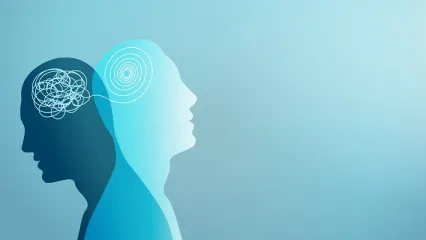Alo Yeditepe
Alo Yeditepe
What are the symptoms of a Panic Attack? How to Overcome a Panic Attack?
What is a Panic Attack?
A panic attack is an attack of intense fear, anxiety or discomfort that occurs unexpectedly and suddenly. It usually lasts for a few minutes and causes the person to feel that they are facing a serious threat or danger, but there is no real danger. The fear experienced during panic attacks can be so intense that the person may think they will lose control, faint or die. They are accompanied by physical symptoms and can often be misinterpreted as a heart attack or a serious health problem. Panic attacks can sometimes happen once, but can often become a recurring condition. In this case, the person may be diagnosed with “panic disorder”.
People with panic disorder constantly worry about when the next panic attack will occur and this can negatively affect their social life, work performance and overall quality of life. Panic attacks can also co-occur with other mental health conditions such as depression and anxiety disorders. The frequency and severity of these attacks varies from person to person, but in general they cause a great deal of discomfort.
What are the symptoms of panic attacks?
Panic attacks are characterized by both physical and emotional symptoms. Symptoms appear suddenly and usually reach their peak within a few minutes. The most common symptoms during a panic attack are as follows:
• Heart palpitations or accelerated heartbeat: The person notices that their heart is beating very fast or that they feel palpitations in their chest. This symptom is quite common during a panic attack and can make you feel like you are having a heart attack.
• Sweating: Sudden and intense sweating is common during an attack.
• Trembling or shaking sensations: People who experience panic attacks may feel their body shaking or jerking involuntarily.
• Shortness of breath or a feeling of suffocation: The person may experience an intense fear of suffocation, thinking that She/He is not breathing enough or that She/He is gasping for air.
• Chest pain or tightness: A feeling of pressure, pain or discomfort in the chest is common and often triggers the fear of a heart attack.
• Dizziness, lightheadedness or fainting: During a panic attack, a person may feel dizzy or feel as if they are going to faint.
• Nausea or abdominal pain: Digestive complaints can be part of panic attacks and may manifest as nausea, gas or abdominal pain.
• Feeling unreal or strange (derealization): The person may have the feeling that everything around them is unreal. This can manifest as feeling like a dream or feeling alienated from their surroundings.
• Fear of death: During a panic attack, a person may experience intense fear that he or she will suddenly die or have a serious health problem.
What Causes Panic Attacks?
Panic attacks are characterized by both physical and emotional symptoms. Symptoms appear suddenly and usually reach their peak within a few minutes. The most common symptoms during a panic attack are as follows:
• Heart palpitations or accelerated heartbeat: The person notices that their heart is beating very fast or that they feel palpitations in their chest. This symptom is quite common during a panic attack and can make you feel like you are having a heart attack.
• Sweating: Sudden and intense sweating is common during an attack.
• Trembling or shaking sensations: People who experience panic attacks may feel their body shaking or jerking involuntarily.
• Shortness of breath or a feeling of suffocation: The person may experience an intense fear of suffocation, thinking that She/He is not breathing enough or that She/He is gasping for air.
• Chest pain or tightness: A feeling of pressure, pain or discomfort in the chest is common and often triggers the fear of a heart attack.
• Dizziness, lightheadedness or fainting: During a panic attack, a person may feel dizzy or feel as if they are going to faint.
• Nausea or abdominal pain: Digestive complaints can be part of panic attacks and may manifest as nausea, gas or abdominal pain.
• Feeling unreal or strange (derealization): The person may have the feeling that everything around them is unreal. This can manifest as feeling like a dream or feeling alienated from their surroundings.
• Fear of death: During a panic attack, a person may experience intense fear that he or she will suddenly die or have a serious health problem.
What is Panic Attack Treatment?
Two main methods are used to treat panic attacks: psychotherapy and medication. These two treatment methods can be applied together or separately and can be customized according to the individual's condition. The most commonly used methods in the treatment of panic attacks are as follows:
• Cognitive Behavioral Therapy (CBT): CBT is a highly effective psychotherapy method for treating panic attacks. This therapy helps the person to recognize and change the negative thought patterns that trigger panic attacks. The person learns how to cope with the thoughts that trigger panic attacks, and the frequency and severity of the attacks are reduced.
• Exposure Therapy: This method of therapy allows the person to face their fears. The person is exposed in a controlled way to situations or objects that they avoid during panic attacks. In this way, they learn to overcome their fears.
• Medication Therapy: Antidepressants and anxiolytics are medications commonly used to treat panic disorder. These medications control panic attacks by balancing brain chemicals. However, they should only be used under the supervision of a doctor.
• Lifestyle Changes: Exercising regularly, eating a healthy diet, paying attention to sleep patterns and learning stress management techniques can reduce the frequency and severity of panic attacks.
What to do During a Panic Attack?
Some steps that can be taken during a panic attack can help manage and relax the situation. Here are some methods that can be applied during a panic attack:
Deep Breathing
• Controlling Breathing:
Try breathing slowly and deeply. Take a deep breath in through your nose, hold it for a few seconds and then slowly exhale through your mouth. This method can slow down your heart rate and help you calm down.
Physical Relaxation
• Relaxing the Muscles
Relax the muscles in your body one at a time. Starting with your toes, relax each muscle group, starting with your toes, and working your way up to the muscles in your legs, abdomen, arms and face. This can help reduce stress.
Mindfulness and Mind Exercises
• Living in the Now:
Remind yourself of what you are feeling, seeing and hearing at that moment. Observe objects, sounds or sensations around you. This can help you regain your reality during a panic attack.
Mental Calming Techniques
• Positive Thoughts:
Repeat positive and realistic sentences to yourself. Sentences like “This is just a panic attack and it will pass” can help calm your mind.
Physical Movement
• Movement:
Try taking a short walk if possible. Walking releases endorphins and can reduce anxiety during a panic attack.
Distraction
• Focus on Something Different:
Do something to distract yourself during a panic attack. Activities such as listening to a favorite song, watching a movie or reading a book can reduce your feelings of panic.
Create a Safe Environment
• Feeling Safe:
Go to a place where you feel safe. If possible, be with someone you trust.
Seek Help
• Seek Support:
If you are alone, reach out to a trusted friend or family member. Talking and getting support can make the situation more manageable.
Seek Professional Help if Needed
• Expert Support:
If your panic attacks are recurring frequently or affecting your life, it is important to seek help from a professional. Therapy and/or medication can help manage the condition.
Trying these steps during a panic attack can be effective, depending on personal experience. Since everyone's situation is different, it is important to discover which techniques work for you.
Frequently Asked Questions About Panic Attacks
How Do Panic Attacks Go Away?
Some strategies during a panic attack can help to control the attacks. Here are some ways to cope with panic attacks:
- Breathing Exercises: Breathing may be difficult during a panic attack. Deep breathing exercises can help calm the body and return the heart rate to normal. Taking a deep breath in through the nose and slowly exhaling through the mouth can be relaxing during an attack.
- Focusing: During a panic attack, focusing on objects in the environment or doing something to occupy the mind (for example, trying to remember the words to a song) can reduce the impact of attacks.
- Muscle Relaxation Techniques: Alternately contracting and relaxing the muscles in the body can reduce the tension of a panic attack.
- Getting Outdoors: Taking a walk or going outdoors can distract the mind during an attack and ease the feeling of panic.
What do people who have experienced panic attacks say?
The experience of panic attacks is often quite intense and frightening. They have to cope with physical and emotional symptoms that start suddenly and intensify within a few minutes. Many people associate panic attacks with a loss of control, fear of death or even a feeling of going crazy. These fearful moments cause the body to react as if it were in danger, which leads to extreme physical and mental stress. Here are the emotions experienced by those who experience panic attacks in their own words:
- “ I thought I was going to die.”
Many people who have a panic attack experience a sudden onset of severe heart palpitations, breathlessness and chest pain. These symptoms can lead people to believe that they are having a heart attack. One person describes the experience as follows: "My heart was beating very fast and my chest was tight. I couldn't breathe and I thought my heart was going to stop at any moment. I really thought I was going to die." - “ Everything became blurry and felt unreal.”
Many people who have panic attacks experience a change in their perception of reality. The world feels unreal, they feel disconnected from everything around them. This is called “derealization” or “depersonalization”. The feeling of alienation from one's own body or surroundings intensifies the fear. One person describes it this way: "Everything around me became blurred. I felt as if everything was a dream, as if nothing was real. At that moment I thought I was completely out of control." - “ I completely lost control.”
During a panic attack, people believe that they have lost control of their body and mind. This makes them feel helpless and makes them feel even worse during the attack. Some people describe this feeling as follows: “My body started shaking and I was covered in sweat and I didn't know what to do. It felt like everything was coming at me and I lost all control.” - “ I couldn't find anywhere to run.”
Panic attack sufferers feel like they are trapped in the middle of danger. No matter what they do, they cannot find a solution to relieve themselves. This leads them to panic even more. One person describes this situation as follows: "I felt like I was in danger, but there was nowhere to run. At that moment it really felt like everything was ending and I didn't know what to do." - “ I felt like I was going to faint.”
Some people who experience panic attacks think they are going to faint or collapse. Symptoms such as dizziness, weakness and loss of balance trigger this feeling. A person experiencing a panic attack describes it as follows: “I started to feel dizzy, I felt like I was going to faint at any moment. The world was spinning around me and I had to hold on to something. I was very scared at that moment.” - “ I felt like no one understood me.”
Panic attacks are often an experience that is not understood by outsiders. Many people may see the person having an attack as physically normal, which can make them feel alone and helpless. One person described this feeling of loneliness as follows: "I felt like no one understood me. Everyone was looking at me, but no one really understood what I was going through. This made me feel even worse." - “ Even when everything is back to normal, the fear remains.”
Panic attacks usually peak within a few minutes and then gradually pass. However, many people carry the fear and anxiety of the experience for a long time after the attack has ended. One person put it this way: "When the attack ended, the physical symptoms went away, but the fear remained in my mind. I was afraid it would happen again and I was constantly on guard."
What are the experiences of people who experience panic attacks at night?
People who have experienced nocturnal panic attacks describe how frightening it is to suddenly wake up from sleep with great fear and anxiety. Having a panic attack even in the most relaxing moment of sleep can leave a person physically and mentally exhausted. Here are some comments about nocturnal panic attacks:
- “ Suddenly I woke up not being able to breathe, my heart was racing and everything came crashing down on me. In the dark everything seemed scarier and I couldn't go back to sleep."
- “ I suddenly wake up at night terrified, feeling as if something bad is going to happen. At that moment, heart palpitations, sweating and shortness of breath completely overtake me. It feels impossible to go back to sleep."
What are the experiences of people who experience panic attacks at night?
People who have experienced nocturnal panic attacks describe how frightening it is to suddenly wake up from sleep with great fear and anxiety. Having a panic attack even in the most relaxing moment of sleep can leave a person physically and mentally exhausted. Here are some comments about nocturnal panic attacks:
- “ Suddenly I woke up not being able to breathe, my heart was racing and everything came crashing down on me. In the dark everything seemed scarier and I couldn't go back to sleep."
- “ I suddenly wake up at night terrified, feeling as if something bad is going to happen. At that moment, heart palpitations, sweating and shortness of breath completely overtake me. It feels impossible to go back to sleep."
What do people who experience panic attacks have in common?
People who experience panic attacks may experience many similar feelings and situations related to the experience. Here are some of the things people with panic attacks have in common:
- Intense Fear and Anxiety: Everyone who has a panic attack experiences an intense feeling of fear and anxiety that comes on suddenly. This feeling is often not based on an irrational fear, but the fear is very real. In these moments, the person may believe that they are having a heart attack or that they are afraid of death.
- Physical Symptoms: Common physical symptoms during panic attacks include heart palpitations, shortness of breath, sweating, shaking, nausea and dizziness. These symptoms can worsen the situation by increasing the fear level of the person experiencing the attack.
- Feeling of Loss of Control: Individuals who experience panic attacks often feel that they have lost control of their body and mind. This leaves them with feelings of helplessness and inadequacy.
- Feelings of Detachment from Reality: During an attack, many people feel disconnected from their surroundings and feel disconnected from reality. This is called “derealization” or “depersonalization” and the person may feel like they are in an unreal world.
- Loneliness and Not Being Understood: Panic attack sufferers may feel lonely, thinking that their condition is not understood by others. The fact that the attacks are invisible increases the feeling of not getting support from others.
- Avoidance Behaviors: The fear of attacks may lead individuals to avoidance behaviors. This may include avoiding crowded places, stressful situations or being alone. These avoidance behaviors can limit social life over time.
- Fear of Relapse: Many people who experience panic attacks live in fear of having another one. This fear can affect their daily lives and create a constant state of alertness. The person tries to create a comfortable environment by avoiding any stressful situation.
- Emotional and Psychological Effects: In the long run, panic attacks can lead to other mental health problems such as depression, social anxiety or generalized anxiety disorder. Traumatic experiences during attacks can negatively affect an individual's emotional state.
- The Recovery Process: Individuals who experience panic attacks often go through a similar recovery process. They may seek ways to control their attacks through therapies, medications, support groups or personal strategies. Some people learn to manage the condition over time with support.
What people who experience panic attacks have in common provides an important basis for understanding and supporting their experience. This can help individuals both to understand their own process and to support others.
What are the Symptoms of Nocturnal Panic Attacks?
Nocturnal panic attacks are attacks that start suddenly while the person is asleep and usually cause the person to wake up in fear. This can have a particularly negative impact on the quality of sleep. Symptoms of nocturnal panic attacks include:
- Waking up with a sudden feeling of fear or panic
- Heart palpitations or chest pain
- Shortness of breath or feeling of suffocation
- Sweating, shivering or chills
- Fear of losing control or death
- Difficulty returning to sleep
Nocturnal panic attacks are more common in people who are usually stressed during the day or have an anxiety disorder.
What are the Symptoms of Anxiety and Panic Attacks?
The symptoms of anxiety and panic attacks are similar, but there are some important differences:
- Anxiety symptoms: Constant worry, tension, muscle tension, stomach problems, sleep disturbances and concentration difficulties. Anxiety is a state of worry that usually lasts for a long time.
- Panic attack symptoms: Unlike anxiety, panic attacks start suddenly and intensify within a few minutes. They are characterized by intense fear and physical symptoms such as heart palpitations, shortness of breath and chest pain.
In both cases, it is important to seek psychological support. Both anxiety and panic attacks can be managed with professional help.
This content was prepared by Yeditepe University Hospitals Medical Editorial Board.
”
See Also
- What is Autism Spectrum Disorder?
- Ways to Treat Anxiety Disorder Without Medication
- What is an Antidepressant? What Does It Do? How Are Antidepressants Used?
- What is Mythomania (Pathological Lying Disorder)? What Causes Mythomania?
- What Does Narcissist Mean? Narcissistic Personality Disorder
- The Importance of Sexuality in Marriage
- What is Anxiety? What are the Symptoms of Anxiety?
- The Father-Child Relationship Reflects on Personality Traits
- Families with Children Who Have Autism Should First Accept the Situation
- Post-Traumatic Stress Disorder
- How to Approach a Child in Adolescence?
- How Can We Manage Stress?
- Chronic Pelvic Pain
- Ways to Deal with Work Stress
- 8 Tips for Fathers Who Want to Develop Healthy Relationships with Their Children
- 9 Different Types of Depression
- Father's Role in Child Development is Fatal
- What is Agoraphobia?
- The Right Behaviors to Shape the Pandemic
- Ways to Survive Coronavirus Stress
- Dancing with Cancer
- What is Specific Learning Disability?
- What is a Mental Disability?
- What is Attention Deficit and Hyperactivity Disorder?
- Developmental Disorders in Children
- Mental Health Starts in the Family
- What is Autism?
- What is Language and Speech Disorders?
- Eco-Anxiety Can Cause Panic Attacks
Alo Yeditepe









